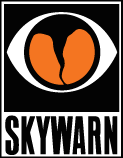 NWS Wakefield SKYWARN
NWS Wakefield SKYWARNAmateur Radio Support Team
WX4AKQ Wakefield, VA
Areas & Frequencies
To help organize SKYWARN members, the Wakefield SKYWARN Amateur Radio Support Team has established nine operational areas across the County Warning Area. You can retrieve frequency and Leadership Team contact information using the links below.
The area boundaries should be more important to us than they are to you as a Spotter. You do not need to call reports in to a specific SKYWARN net. Use whatever SKYWARN net you can reach to call in your report, even if it's a neighboring NWS office. Your report will get where it needs to go!
To view SKYWARN frequencies for any area, click on the area number/name in the list below.
SKYWARN Areas
- Area 1 - Richmond
- Area 2 - Southside VA
- Area 3 - Williamsburg/Smithfield
- Area 5 - Southeast VA
- Area 7 - Northeast NC
- Area 8 - Northern Neck
- Area 11 - DMR
SKYWARN Maps
We offer online maps of current SKYWARN area boundaries and official SKYWARN repeaters within our CWA.
Individual area maps/files are available by viewing an area's page in the list above.
View our online map or download a KML file for offline viewing
Recommended Frequencies for Storm Chasers
Storm chasing teams are discouraged from placing routine chase coordination traffic and related discussion on SKYWARN repeaters. Recommended common frequencies for all chase teams operating in the Wakefield CWA can now be found on our ICS205 Comm Plan and are as follows:
Channel Name Frequency Mode Tone Description
------------- ------------- ---------- --------- --------------------
Chase 1 146.5500 MHz WFM CSQ Nationwide Primary
Chase 2 146.4600 MHz WFM CSQ Nationwide Alternate
Chase 3 446.1000 MHz WFM CSQ Nationwide UHF
Chase 4 147.5100 MHz WFM DPL 255 Local/TAC 1
Chase 5 147.5850 MHz WFM DPL 255 Local/TAC 2
Digital 1 441.0375 MHz D-Star DV n/a DSTAR simplex
Digital 2 441.0625 MHz DMR CC1/TS1 DMR simplex, TG# 99
Additional channels for GMRS users:
Channel Name Frequency Mode Tone Description
------------- ------------- ---------- --------- --------------------
Chase 10 462.5500 MHz WFM PL 127.3 GMRS Primary
Chase 11 462.7000 MHz WFM PL 156.7 GMRS Alternate
These frequencies are recommended common frequencies for use by SKYWARN-affiliated storm chasers operating in the Wakefield CWA. Individual spotters and chase teams are welcome to designate their own additional standard frequencies, but all chasers are encouraged to have these frequencies, when compatible, programmed into their radios. These frequencies are not monitored in any official capacity by any SKYWARN Net Control Operators, the SKYWARN Radio Desk, or NWS personnel.
ICS205 Communications Plans
Each SKYWARN area has a separate ICS205 Communications Plan. The latest ICS205 for each area can be viewed here.